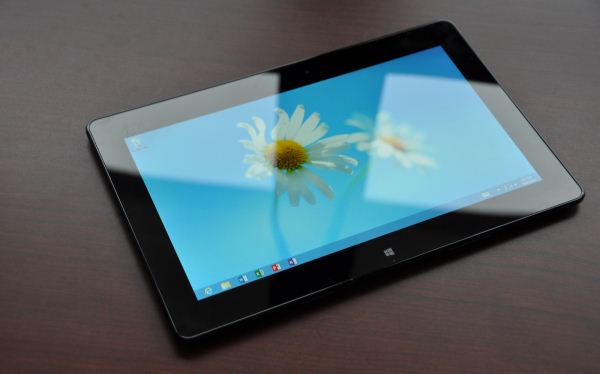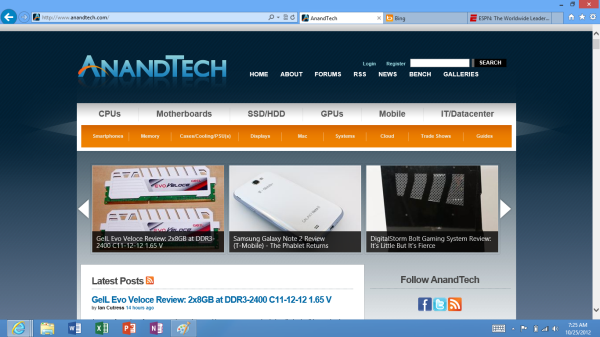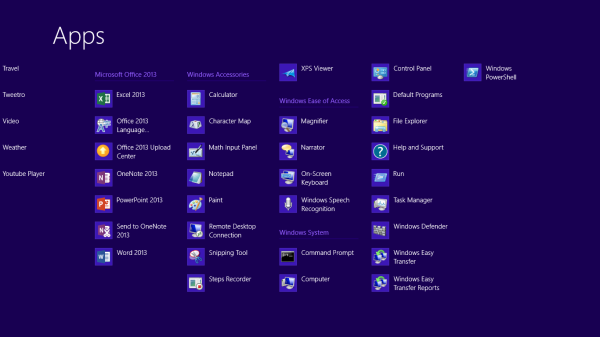The Windows RT Review
by Vivek Gowri & Anand Lal Shimpi on October 25, 2012 12:00 PM EST- Posted in
- Windows RT
- Operating Systems
- Microsoft
- Mobile
- Windows 8
- Tablets
Bridging the Gap, the Dichotomy of Windows RT
by Anand Shimpi
I described Windows RT as being a tablet OS with all of the underlying Windows-ness of Windows. You can get the big full screen app experience in tablet mode, but poke around your file system with Explorer or use Office 2013 like you would on a traditional notebook if you want to. If the two sides of Windows RT remained fairly separate that’d be one thing, unfortunately there are some dependencies between the two sides of the OS that keep the overall user experience from being as friendly as it is in iOS. There are still occasional reminders that you’re dealing with something that’s distinctly Windows here.
Most mobile OSes have done their best to hide the underlying file system and shell from the end user. Microsoft did, in my opinion, the smart thing and avoided hiding its roots with Windows RT. Although the new Start Screen is the default UI for Windows RT, there’s a big desktop tile front and center that will take you back to something far more familiar:
Unlike the Windows 8 desktop, you’re pretty limited in what you can do here. The only applications that are allowed to run in desktop mode under Windows RT are Explorer, IE10, Office 2013 and the command prompt (there are also all of the Windows specific tools and settings which I’ll get to shortly). Developers cannot make applications for Windows RT desktop mode and you can’t sideload anything here. Microsoft’s belief is that by completely locking down the system, requiring that applications only come from the Windows Store, it can avoid the pitfalls of viruses and malware that can plague Windows machines today.
Steve Sinofsky famously quoted an analyst when they asked if Windows RT would be backwards compatible with all of the legacy Windows viruses and spyware. The answer was an astounding no, and this is exactly why we can’t have open season on Windows RT desktop development. There’s also the obvious financial angle to all of this. Microsoft takes a cut of any apps sold through the Windows Store.
Coming from the perspective of a traditional Windows user, the lack of flexibility on the desktop seems wrong. From the perspective of the rest of the ARM based tablet space, it’s not a big deal. At least Windows RT gives you direct, first party access to the file system. There’s very little exposed through iOS, and with Android you need to download a third party app to get access to the file system.
Explorer works just as it would on a Windows 8 PC. The folder structure is exactly as you would expect it on any Windows machine. There are even some x86 remnants in the Windows RT install such as a C:\Windows\SysWOW64 directory complete with x86 binaries inside that obviously won’t run on your Windows RT tablet.
Internet Explorer in desktop mode works just like a traditional IE windows application would work. The desktop app actually controls settings and features for the Metro...err...fancy IE10. For example, if you want to change security settings, clear your history or empty your cache, you have to do all of these things from the IE10 desktop application. Fancy IE10 doesn’t expose them.
The command prompt is, well, a command prompt. It features all of the same commands that you could run before, although once again you can’t simply drop an x86 exe on your system and run it. Not having binary compatibility can be frustrating at times.
Although developers can’t build applications for Windows RT’s desktop, you can write and execute batch files. Keep in mind that if your batch file needs any additional support files (e.g. sleep.exe) you’ll need ARM versions of them which, unless they come from Microsoft, just isn’t happening.
As I mentioned earlier, there are a few other things you can run and do in RT’s desktop mode. Control Panel, event viewer, disk management and all of the other administrative tools that you’d expect to come with Windows are present in Windows RT (including regedit). There are also the little apps that Microsoft has always included, which also work in desktop mode (e.g. mspaint, calc, notepad, etc...)
Ultimately Windows RT is an ARM version of Windows with tablet makeup on. You still get all of the normal bits and pieces of Windows, minus some flexibility and of course, backwards compatibility.
For years we’ve been asking Microsoft to make a clean break with its legacy code and introduce a version of Windows that was built from scratch, with only support for the latest hardware. With Windows RT, Microsoft finally delivered some of that, but in a sort of weird, backwards way.
As Windows RT only supports the ARMv7 instruction set architecture, none of your old x86 applications will run on the platform. Microsoft hoped to avoid this being a problem by shipping an ARM version of Office 2013 Home & Student Edition with Windows RT tablets, and by directing users at the Windows Store for the rest of their application needs. Although it would’ve been possible for Microsoft to enable x86 compatibility through emulation or binary translation, performance would’ve likely been pretty bad.
The loss of backwards compatibility with years of Windows applications feels wrong, but from Microsoft's perspective you don't get that with iOS and Android so there's no real competitive disadvantage here. Why bother with an ARM based version of Windows to begin with? To bring competition to Intel and ensure that it will be able to deliver Windows to the new wave of ultra mobile devices (e.g. tablets). Intel hasn't been competitive on power or pricing at the low end (read: Atom) of the spectrum for years now. The introduction of Windows RT changed that. Atom Z2760 (Clovertrail) is around half the price of the cheapest Atom CPU of the past five years, and it's price competitive with solutions from Qualcomm. We have Windows RT to thank for that. Without pressure from ARM, Clovertrail would've started around $50 per chip just like Intel's low end parts had in the past. As AMD is no longer a pricing check for Intel in some of these new markets, Microsoft had to look for a new way to offer balance. Supporting ARM is its way of doing that. Until there's a new pricing/power/performance x86 competitor to Intel in tablets, ARM and Windows RT will remain.














233 Comments
View All Comments
tipoo - Friday, October 26, 2012 - link
I'd like to know that as well. But if it kills even my Core 2 Duo, I don't expect current ARM chips to fare well with that many tabs, but I'd still like to know how it handles background tab loading.Mahadragon - Friday, October 26, 2012 - link
Thanks Anand for the best review of RT I've seen yet. Gives me better idea of what's to come, however it doesn't address the question should I buy Win8 for desktop? The upgrade offer ($40) is out now but I don't seen compelling reason to buy it. You mentioned in your review that Apple has their desktop computer and mobile offerings separate, but the way Win8 is being implemented it sounds like maybe they should have kept it that way.In your review you said it was jarring how it would revert back to the desktop environment when you touched on a desktop app. It's comments like this that make me wonder why upgrade from Win 7? Are the apps that will eventually come to the desktop be all that useful? I suppose if there were a handy Calendar App that could auto-sync with my mobile device that would be nice, but there are already many apps (like Google Calendar) that I can already use to sync between mobile devices.
Your review has given a great many reasons to purchase a Surface tablet, but that's not the decision many of us are facing right now. $500 is not chump change and that doesn't even include the keyboard which is another $100. I just bought a new iPod Touch and will be using that for mobile computing since my Windows Phone 7 device is not nearly as user friendly.
I think MSFT could have kept Win8 same as Win7 with an option to run ARM apps built-in. I think this would have made more sense since they don't have too many apps to begin with. Also, I don't think these little apps, which are optimized for tablet, will necessarily give a great experience on a desktop monitor that you won't be touching.
It almost seems like MSFT is trying to encourage people to buy the tablet by frustrating them with a rough desktop experience and making it smooth on the Surface. Thank you for going over the history of MSFT's initial forays into the tablet space. It's something very few people realize. Yes, MSFT, always the innovator was the first to come out with a tablet over 10 years ago, but nobody even knew about it.
Fortunately for MSFT, there is a god (or rather, Apple) who has always been there to show them the light. Apple: "Use a touchscreen, not a stylus!" MSFT: "Ok, sorry, we thought everyone would cherish the thought of using a digital pen to interact with their tablets. Apple: "Make an App Store and sell software programs through it so people can add functionality to their devices!" MSFT: "Ok, that's a great idea, wish we thought of that." Apple: "Add a camera! People like to take photos." MSFT: "Done." Apple: "Come out with your own retail stores so you can sell to people directly!" MSFT: "Ok, we can do that." Apple: "Always remember to copy us verbatim but not too much. We don't want to have to sue you (again)." MSFT: "Ok, we'll make our products geeky instead of dead sexy how about that?"
yyrkoon - Sunday, October 28, 2012 - link
If you're already using Windows 7, chances are pretty good that you'd just be wasting money.Windows 8 obviously was made for mobile devices. Then perhaps it will perform somewhat faster on the same hardware. But if you're looking for better gaming performance you probably will not see much of a difference there.
The app store is a terrible idea in its current incarnation. I do not know many ( any ) software developers who would be happy about paying a 30% forced fee for any software platform. These same developers who draw users en mass to an operating system by creating many, useful applications. Or, I should say *did*.
Dorek - Friday, November 2, 2012 - link
"Apple: "Add a camera! People like to take photos.""Uh, the Surface doesn't have a rear camera. Rear cameras on tablets are freaking stupid.
Anyway, if you care about such things, Windows 8 has much faster performance than Windows 7. Well worth $40 bucks to me.
shermanx - Friday, October 26, 2012 - link
where's the Wacom digitizer/pen/stylus? while so many tablets are trying to be different from others, I am surprised how few have included a functional pen for taking notes. that is really important feature for education business, and there's nothing that's really working well now. I just need Wacom Bamboo level of experience with a screen on it at a reasonable price.darkcrayon - Saturday, October 27, 2012 - link
There will be a digitizer on the Surface Pro, though I think the pro will be even more of a different market than the RT, considering it will be even larger and heavier.yyrkoon - Friday, October 26, 2012 - link
"The only applications that are allowed to run in desktop mode under Windows RT are Explorer, IE10, Office 2013 and the command prompt "This will either make or break Windows RT. Also, I bet this is a form of DRM imposed by Microsoft. While not DRM per se, they get to say which application we can install on our systems. Good, or bad ? I really do not know. It really depends on how they implement their online store. As I have not used windows 8, or Win RT. However, if it is similar to the google app store. Developers are required to pay an annual $25 USD fee. Which if you ask me, is slightly detrimental to the given community. In that people will be more inclined to charge for their applications, instead of providing FOSS( free open source software ). $25 USD though, really is not all that much.
One thing I can say however. Is that Microsoft sure is pushing their latest mobile software development kits through their mailing lists. Good or bad ? Again, I do not know. I am currently with android development, and unless I see something inspirational from Microsoft. That will likely not change soon. If ever. That is, for mobile devices. On the desktop I still prefer to develop with / on Windows using the .NET base class library.
yyrkoon - Friday, October 26, 2012 - link
Also Anand,I really do not think third party apps will be a problem. At least where the browser applications are concerned. With all the javascript libraries that abound now days, coupled with HTML5 and CSS3. "Offline webapps" will be easy to make, and provide a lot of possibilities. These apps, should work the same on any OS.
Native apps . . .is where Microsoft excels on the desktop At least from a developers standpoint. The .NET base class library takes a lot of work out of software development, and provides many, many useful classes. How this works, or will work cross platform from x86 to ARM I am not exactly sure. But I suspect Microsoft has it covered. As always. Having done a lot of research lately on mobile device development, I know that Microsoft is providing a lot of software development kits. Some that look extremely attractive at first look.
From a software developers standpoint. Windows 8 / Windows RT looks really attractive right now. Since the market is virtually wide open for software developers to make themselves a name.
Now do keep in mind that everything mentioned above is from a developers mindset. As a user . . . yours truly really likes to keep as much freedom as possible. How that works out again is based on how Microsoft implements their app store. Also, if Microsoft can somehow remove the mobile device from the stigma of being a toy. I think they'll have it nailed. We know the OS polish is going to be there for anything Windows lately. So it basically boils down to ( again ) good software availability.
yyrkoon - Saturday, October 27, 2012 - link
Yeah, disregard what I said above.According to what I have just read. Microsoft wants a 30% fee for using their app store. From the developer . . . so yeah Microsoft can kiss my ass as far as Windows RT is concerned.
If they keep on like this, personally I do not care how much work the .NET framework saves me. I will move to another platform and write off their operating systems al together. And I know im not alone.
~joe - Saturday, October 27, 2012 - link
I have one question to anybody owning Windows RT device (particualry Surface). I'm writting from Poland, and so far there is no plans for selling this device here. So I want to buy my in USA. My intention of use is 70% content consumption and 30% content creation using Office. But I need for my work Polish language. The question is - can I switch language to Polish (or ownload Polish language pack)?